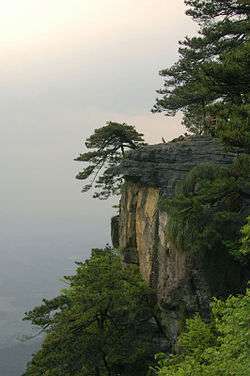Mount Lu
| Lushan National Park | |
|---|---|
| Name as inscribed on the World Heritage List | |
|
| |
| Type | Cultural |
| Criteria | ii, iii, iv, vi |
| Reference | 778 |
| UNESCO region | Asia-Pacific |
| Inscription history | |
| Inscription | 1996 (20th Session) |

Mount Lu or Lushan (simplified Chinese: 庐山; traditional Chinese: 廬山; pinyin: Lúshān, Gan: Lu-san), also known as Kuanglu (匡庐) in ancient times, is situated in the northern part of Jiangxi province in southeastern China, and is one of the most renowned mountains in the country. The oval-shaped mountains are about 25 km long and 10 km wide, and neighbors Jiujiang city and the Yangtze River to the north, Nanchang city to the south, and Poyang Lake to the east. Its highest point is Dahanyang Peak (大汉阳峰), reaching 1,474 m above sea level, and is one of the hundreds of steep peaks that towers above a sea of clouds that encompass the mountains for almost 200 days out of the year. Mount Lu is known for its grandeur, steepness, and beauty, and is part of Lushan National Park, a UNESCO World Heritage Site since 1996, and a prominent tourist attraction, especially during the summer months when the weather is cooler.
Lushan was a summer resort for Western missionaries in China. Absalom Sydenstricker, the father of Pearl Buck was one of the first five missionaries to acquire property in the Kuling Estate on the mountain.
Attractions and Features
Popular attractions in Mount Lu include the Immortal Caverns (仙人洞), Meilu Outhouse (美庐别墅), Five Old Man Peaks (五老峰), White Deer Cavern Academy (白鹿洞书院), Three Tiled Springs (三叠泉), Luling Lake (芦林湖), Lushan Hot Springs (庐山温泉), Botanical Gardens (植物园), the Bamboo Temple (竹山寺), Guanyin Bridge (观音桥), Peach Blossom Garden (桃花源), and many more.
- Huiyuan founded Pure Land Buddhism here on the northwest slope in 402. Donglin Temple is also located here.
- Lushan National Park is a UNESCO World Heritage Site,[1] and Lushan Quaternary Glaciation National Geopark is a member of UNESCO Global Geoparks Network.
- The Lushan Botanical Gardens features tens of thousands of plant species.
- Below the Five Old Men Peak is the White Deer Grotto Academy, named after the poet Li Bo (Chinese: 李渤) (not to be confused with the famous poet Li Bai), who raised white deer there. It is one of the most famous higher learning institutions in ancient China.
- West is the Flower Path which provided inspiration to Bai Juyi, a famous poet who lived during the Tang Dynasty.
- Between the Yangtze River and Lake Poyang lie the Greater and Lesser Tianchi Lakes, the Jingxiu Valley, and Lulin Lake. On the north bank of the latter is the Lushan Museum, which features pottery and bronzes dating from various periods of ancient China, as well as calligraphy from the Tang Dynasty and paintings from the Ming and Qing dynasties.
- At the centre (between three peaks), and at an altitude of over 1 kilometer above sea level, is the town of Guling, which is linked by a mountain highway to neighboring spots in the region.
- World-famous Lushan Clouds and Mist Tea (simplified Chinese: 庐山云雾茶; traditional Chinese: 廬山云霧茶) is grown in the mountains.
Political Significance
Mount Lu was once dubbed the xiadu ("summer capital") of the Republic of China. Chiang Kai-shek, China's leader at the time, would frequently spend his summers here. In June 1937, Zhou Enlai, then a major leader in the Communist Party, met with Chiang on the mountain to discuss a united front against the Japanese invasion. In July 1937, Chiang Kai-shek announced his intention for a full mobilization for war against Japan from Mount Lu. In 1946, following the war, the U.S. special diplomatic mission led by General George C. Marshall met with Chiang Kai-Shek to discuss the role of post-World War II China.
Mao Zedong convened three large conferences of senior party officials at Mount Lu, in 1959, 1961, and 1970. The 1959 conference became known as the Lushan Conference. The meeting saw the purge of decorated Chinese Civil War and Korean War general Peng Dehuai, who was critical of Mao's Great Leap Forward policies. The 1970 Lushan Conference took place during the Cultural Revolution, and marked the increasing antagonism between those loyal to Mao and those loyal to his chosen successor Lin Biao.
Gallery
- Sun rise at Mount Lu
- Mountain Immortals Cave
- Town of Guling
- Meilu building, Chiang Kai-sek's former residence
 Old church
Old church Old church
Old church- Lake Lulin
- Donglin temple
- White Deer Grotte Academy
 Lofty Mount Lu by Shen Zhou, 1467
Lofty Mount Lu by Shen Zhou, 1467
References
| Wikivoyage has a travel guide for Lushan. |
| Wikimedia Commons has media related to Lushan Geopark. |
- ↑ "Lushan National Park — UNESCO World Heritage Centre". Whc.unesco.org. 2012-01-02. Retrieved 2012-12-24.
Coordinates: 29°34′21″N 115°58′24″E / 29.57250°N 115.97333°E

